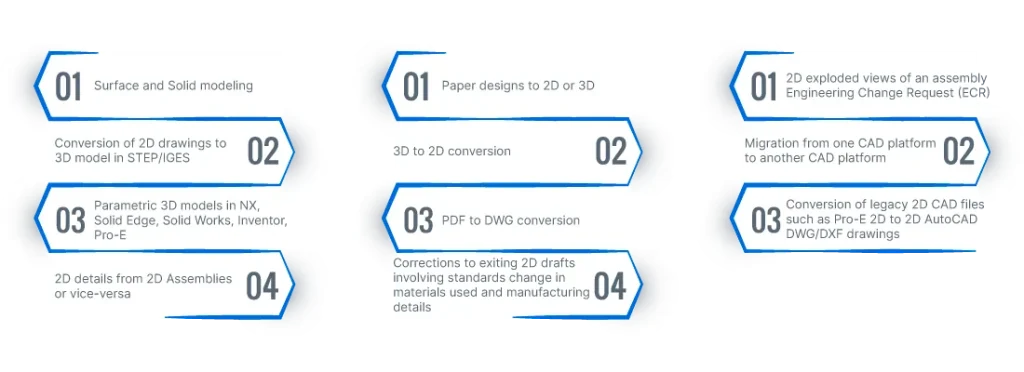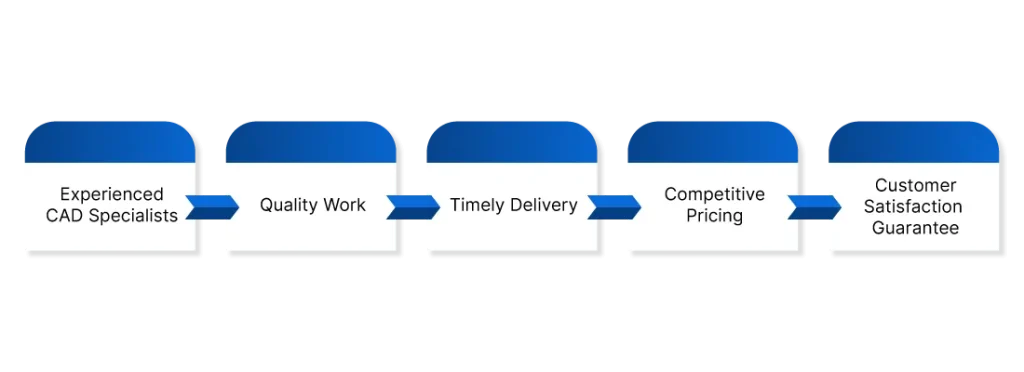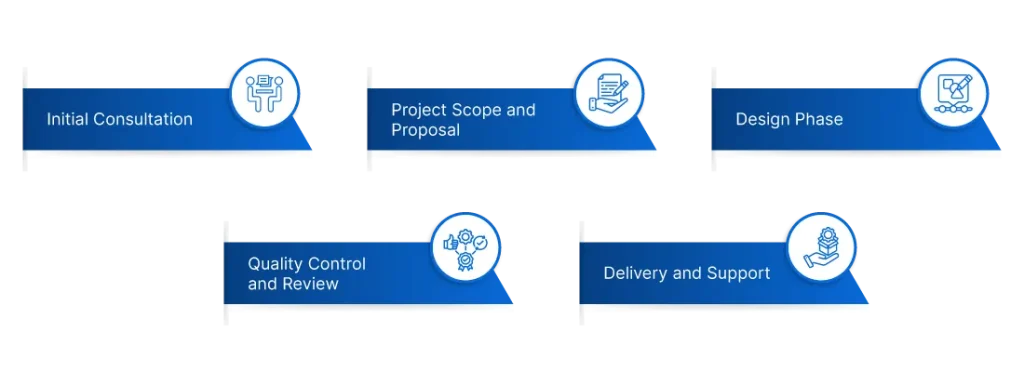Reverse Engineering CAD Engineering Services
Are you looking for high-quality and accurate 3D CAD design services for your next project? Look no further! Our team of experienced CAD specialists is here to help you bring your designs to life. We offer a wide range of CAD design services, including 3D modeling, 2D drafting, conversion, and migration services. Our CAD design process is transparent, efficient, and collaborative. We work closely with our clients to understand their requirements, and we provide regular updates throughout the design process to ensure that the final designs meet their expectations. Our process includes an initial consultation, project scope and proposal, design phase, quality control and review, and delivery and support. With our CAD design services, we can assure you of working with experienced CAD specialists who deliver quality work on time and at a competitive price.
Our CAD specialists have extensive experience in building 3D models, ranging from simple designs to complex assemblies, using a variety of software tools such as NX, Solid Edge, SolidWorks, Creo, Autodesk Inventor, CATIA, and more. We work closely with our clients to understand their requirements and provide accurate 3D models that meet their needs.
We understand the importance of accurate 2D drafting in the CAD design process, and we offer drafting services that cover all your needs. Our drafting services include converting your paper drawings and blueprints to digital formats, creating 2D drawings from 3D models, and drafting services for files from other CAD software platforms. We use industry-standard software tools such as AutoCAD and SolidWorks to create accurate and unambiguous 2D drawings that convey all the required information to the manufacturer.
We understand that many companies have legacy data in various file formats, and we offer conversion and migration services to help you move your data to a more modern platform. Our conversion and migration services can cover all your paper drawings, blueprints, and even files from other CAD software platforms. We can convert files to and from various formats, ensuring that you can work with your data in the software tools of your choice. We also offer additional services such as rendering and simulation, product design and development, reverse engineering, and more. Our team of CAD specialists has extensive experience in a wide range of industries, including aerospace, automotive, consumer products, and medical devices, among others. We pride ourselves on providing quality work, timely delivery, and competitive pricing to ensure customer satisfaction.
Conversion of 2D drawings to 3D model in STEP/IGES




Professionalism and work ethics… "The level of professionalism and work ethic you bring to the table is simply great. The fact that clicked the most is when you took complete responsibility for our product development and the outcome is exactly what we desired. Thank you Prescient."

First on our list, without doubt … “I greatly appreciate the software development work you have been doing for Level 3 Inspection for all these years. Your team’s skills and your methodical approach to perfection, coupled with your high level of professionalism, have made the road pretty smooth for us to achieve our organizational and operational integration goals. If we have to recommend a competent partner we can totally depend on, your name would be the first on our list, without a doubt. Thank you Prescient!”

They are the exception... "We've been working with Prescient Technologies for quite a few years now, and they continue to provide quality work in a timely manner for a reasonable cost. They are the exception to the two out of three rule! (Fast, High Quality or Good Price, pick two)"

There could not have been a better alternative… "It was a chance meeting with the Prescient team that set the ball rolling. Initially I was skeptical but their attitude “Together we can” inspired confidence. ”Hand-holding” by Prescient was exemplary and that was crucial for a start-up like ours. Our project in Orthopaedic navigation involved totally new objectives in as yet unexplored areas to be achieved with innovative steps in CAD domain. Few years down the line together we have added a chapter at the very edge of scientific knowledge. Thanks to Prescient our software idea has now evolved into a full-fledged market-ready product. Today I am convinced that there could not have been a better alternative."

Professionalism and work ethics… "The level of professionalism and work ethic you bring to the table is simply great. The fact that clicked the most is when you took complete responsibility for our product development and the outcome is exactly what we desired. Thank you Prescient."
Our CAD design services are suitable for a wide range of industries, including manufacturing, automotive, aerospace, defense, architecture, and many others. We have experience in creating 3D models and 2D drawings for various products, components, and systems.
Our team of CAD specialists has expertise in using a variety of software tools, including NX, Solid Edge, SolidWorks, Creo, Autodesk Inventor, CATIA, and more. We can work with the software tools of your choice.
Yes, we offer conversion and migration services that can cover all your paper drawings, blueprints, and even files from other CAD software platforms. We can convert your paper drawings or blueprints into 3D models and 2D drawings that are accurate and high quality.
The timeline for a CAD design project depends on the complexity of the project, the scope of work, and the number of revisions required. We will provide you with a timeline estimate during the initial consultation phase.
Yes, we encourage our clients to provide feedback and request changes or revisions to the designs throughout the design process. We will work closely with you to ensure that the final designs meet your requirements and expectations.
We have a rigorous quality control and review process that includes multiple checks and tests to ensure the accuracy and quality of the CAD designs. Our team of CAD specialists also has extensive experience in creating 3D models and 2D drawings that are precise and reliable.
Yes, we offer CAD design services for both prototypes and small production runs. Our team can work with you to design and create 3D models and 2D drawings that are optimized for manufacturing and production.
Yes, we are committed to protecting the confidentiality and intellectual property of our clients. We are happy to sign an NDA or any other legal agreements that are required to ensure the protection of your information and designs.
We can deliver the final CAD designs in a variety of file formats, including IGES, STEP, STL, PDF, and others. We will work with you to determine the best file format for your specific needs and requirements.
Pune, India – 07/04/2025 – Prescient Technologies, a leading provider of advancedtechnology solutions and digital transformation services, today announced the launch ofits refreshed brand identity. The new look and messaging reflect Prescient’s renewedpurpose and evolving role as a future-forward, innovation-driven partner to globalindustries. At the heart of the new identity is a bold, modern logo with a standout orange dot on the“i”—symbolizing the spark of insight, creativity, and human-centric thinking that definesPrescient. The refreshed color palette and clean typography convey trust, clarity, andforward momentum. The refreshed identity is built on four strategic brand pillars—Integrity, Innovation,Infinity, and Impact—represented by the letter “i” in the logo. These pillars reflectPrescient’s approach to building long-term value and lasting partnerships: “These four pillars are not just values—they are the lens through whichwe deliver every solution,” said Deepti Waghmare, Director – Admin, Legal and HR. “Integrity means we stay transparent and accountable. Innovationreflects our passion for bold thinking. Infinity shows our belief inlimitless potential. And Impact is our commitment to real, measurableoutcomes.” said Deepti Waghmare, Director – Admin, Legal and HR. “Prescient has always stood for deep expertise, reliability, andforesight,” said Pravin Waghmare, CEO of Prescient Technologies.“With this new identity, we are embracing the future while staying trueto our core. It reflects how we approach every challenge, every solution, and every relationship.” “This new brand is a reflection of the evolution our customers areseeing in us,” said Ram Deshpande, VP – Sales and Marketing. “Itcommunicates who we are today—agile, future-ready, and deeply committed to our clients’ success. Our brand now mirrors the energy and ambition that drives Prescient forward.” With over two decades of technology excellence, Prescient is poised to accelerate itsglobal reach, expand digital services, and continue empowering organizations acrossmanufacturing, industrial automation, and enterprise software landscapes. Logo Decoded The Prescient logo blends simplicity with significance. Its clean, rounded typographyreflects a modern and approachable personality, while the calming blue symbolizestrust, reliability, and depth of expertise. The standout orange dot on the “i” adds a sparkof creativity—representing insight, agility, and the human touch at the heart of everysolution.The letter “i” in the logo carries deeper meaning—it embodies Prescient’s fourfoundational pillars: 1. Integrity: We uphold transparency, honesty, and accountability in everyrelationship and every solution.2. Innovation: We constantly push boundaries, embrace new ideas, and craftsolutions that shape the future.3. Infinity: Our thinking, solutions, and ambitions are limitless, reflecting our beliefin continuous evolution and boundless possibilities.4. Impact: We focus on delivering meaningful outcomes—creating real value forour clients, communities, and industries. Together, these elements form a bold, balanced, and forward-movingidentity—capturing Prescient’s unwavering spirit and purpose Media Contact: marketing@pre-scient.com
Read MoreThe ecommerce industry will go through a remarkable transformation in 2025. It is driven by digital innovation and changing consumer expectations. Personalisation has become the new norm as customers increasingly seek tailored shopping experiences. At the heart of this trend are ecommerce product configurators. They are powerful tools that allow consumers to customise products in real-time. These configurators are revolutionising both B2B and B2C commerce. They are effectively closing the gap between customer preferences and business offerings. It is very clear in the fashion and automotive industries. Here, visual configurators have emerged as indispensable tools. They are increasing customer engagement and enhancing sales performance. What Is an Ecommerce Product Configurator? An e-commerce product configurator is a digital interactive tool on an ecommerce website. It enables customers to customise products before buying. Key Features Benefits The Role of Product Configurators in Ecommerce Product configurators meet the customer expectations of personalisation and interactivity. Expectations and Offerings In an era where consumers seek more control, configurators allow businesses to adapt their products to varied customer preferences. Industries Leveraging Configurators Top Features of Modern Product Configurators The latest product configurators incorporate advanced technology to provide seamless user experiences: These features make configurators valuable tools for improving customer satisfaction and operational efficiency. How Product Configurators Drive Sales Growth Visual configurators have a direct and measurable impact on sales performance: Case Studies: Most companies report a 20%–30% conversion rate increase and up to 50% growth in average order values after using configurators for engineering process automation. Overcoming Implementation Challenges While configurators have much potential, their implementation is not simple: Solutions Future Trends of Ecommerce Product Configurators in 2025 The future of ecommerce product configurators will continue changing, with these trends influencing its future: Conclusion In 2025, ecommerce product configurators will be a necessity for businesses seeking to stay competitive. These tools represent a significant leap forward in ecommerce innovation. With increasing consumer expectations, businesses have no choice but to use configurators in order to meet the interactivity and personalisation requirements that their customers are demanding. By doing so, they will increase engagement sales and lead in the fast-paced ecommerce landscape. Revolutionise Your Engineering Processes with Prescient’s Digital Thread Effectively link each aspect of your engineering activities through the Prescient Technologies Digital Thread. With this innovative technology, it enables organisations to automate workflows, eliminate inefficiencies, and increase collaboration through product lifecycles. Whether it is design iteration, real-time data integration, or traceability from concept to production, Prescient’s Digital Thread delivers unparalleled precision and agility. Join the future of engineering process automation, where innovation harmonises with efficiency. Start your journey to operational excellence. Explore Prescient’s Digital Thread today!
Read MoreSustainability is now a business necessity. Energy optimisation has become critical for companies across sectors. Rising energy costs and environmental regulations have propelled the adoption of Energy Management System Software. These systems reduce costs and contribute to a greener planet. They ultimately minimise energy waste. Knowing each type of energy management system is crucial to helping businesses improve efficiency and succeed. Let’s look at the applications and the value propositions these systems uphold. What Are the Four Types of Energy Management? EMS belongs to diverse use applications. These mainly include the four types described next: 1. Building Energy Management Systems (BEMS) BEMS optimises energy usage in commercial and institutional buildings. Example: A corporate office using BEMS can reduce energy consumption by 20%. It can change HVAC settings based on occupancy. 2. Industrial Energy Management Systems (IEMS) IEMS is tailored for manufacturing and production facilities. It focuses on reducing energy-intensive operations. Example: 25% of energy usage can be reduced in a factory through predictive maintenance. 3. Residential Energy Management Systems (REMS) REMS for home and housing complexes, wherein smart devices can automatically control the usage of energy Example: A homeowner can save 10% on energy by using a REMS app. The app can time the running of high-energy appliances during off-peak hours. 4. Utility Energy Management Systems (UEMS) UEMS is for utility companies that focus on the grid energy distribution level. Example: A utility company can use UEMS to control peak demand during a heatwave, avoiding power cuts while still being energy efficient. What Are Examples of Energy Management Systems? Energy Management Systems have been applied in many industries: Hypothetical Case: A logistics firm using EMS to monitor and manage warehouse energy usage will reduce its energy costs by 30%. Such is the direct business value offered by the system. How do you select the appropriate EMS? In essence, the features offered by EMS must match the business’s requirements. Some factors that dictate the selection are scalability, real-time analytics, and ease of integration. What Are the Components of Energy Management Systems? Energy Management System Software consists of three essential elements: 1. Real-Time Monitoring 2. Automated Controls 3. Energy Forecasting Value Proposition: These parts collectively reduce operational expenses, ensure environmental compliance, and support sustainability. For example, digital logbooks can record and analyse factory data online, saving thousands of dollars annually in paper resources. What is the Difference Between EMS and SCADA? EMS and SCADA are both critical components of modern industrial operations. However, they serve different purposes: Energy Management System (EMS) SCADA Synergy: EMS and SCADA integrate energy-specific information with comprehensive process control. In doing so, businesses can take full advantage of their resources in a way that leads to enhanced efficiency. How Do EMS Systems Add Value? Energy Management Systems offer quantifiable benefits: 1. Cost Efficiency 2. Improved Operational Efficiency 3. Sustainability Objectives Conclusion Energy efficiency is increasingly becoming a competitive differentiator. Hence, energy management systems are essential for businesses that want to be ahead of their competitors. Integrating digital logbooks and energy forecasting further enhances their effectiveness. Adopting an EMS pays off in the long run. They can help reduce costs and future-proof operations. Transform Your Energy Management with powerCONNECT Take charge of your energy use with powerCONNECT, the latest Energy Management System Software from Prescient Technologies. It is designed to maximise energy usage and achieve sustainability goals. Its features include real-time monitoring and predictive analytics. Both these latest technologies are available with a customisable dashboard. Power up your operations with actionable insights and unmatched efficiency. powerCONNECT is the scalable solution to stay competitive in today’s energy-conscious world. Get on the right path toward your goal of smarter and greener operations. Learn more about how Prescient Technologies can help. Schedule a demo today!
Read More